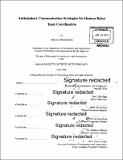| dc.contributor.advisor | Julie Shah. | en_US |
| dc.contributor.author | Butchibabu, Abhizna | en_US |
| dc.contributor.other | Massachusetts Institute of Technology. Department of Aeronautics and Astronautics. | en_US |
| dc.date.accessioned | 2016-12-05T19:54:16Z | |
| dc.date.available | 2016-12-05T19:54:16Z | |
| dc.date.copyright | 2016 | en_US |
| dc.date.issued | 2016 | en_US |
| dc.identifier.uri | http://hdl.handle.net/1721.1/105597 | |
| dc.description | Thesis: Ph. D., Massachusetts Institute of Technology, Department of Aeronautics and Astronautics, 2016. | en_US |
| dc.description | Cataloged from PDF version of thesis. Page 131 blank. | en_US |
| dc.description | Includes bibliographical references (pages 112-118). | en_US |
| dc.description.abstract | Increasing prevalence of autonomous systems has generated interest in effective inclusion of robots as team members in many domains, especially where complex and safety-critical tasks must be performed. We envision a world where autonomous systems can be seamlessly integrated into high performing human teams. In order for team members to successfully work in concert to achieve a goal, the team must establish a common understanding of the task expectations and communicate effectively. In this dissertation , we drew inspiration from studies of effective human teamwork, which showed that best performing human teams exploit anticipatory coordination strategies (referred to as implicit coordination) to selectively communicate information based on the perceived needs of the other members in the team instead of requesting for information (referred to as explicit coordination). We elaborated upon prior characterizations of communication as implicit versus explicit by dividing implicit communication into two subtypes: (1) goal-based information (referred to as deliberative-implicit communication) and (2) status updates (referred to as reactive-implicit communication). Based on an empirical study conducted using 13 teams of 4 people working on a collaborative search-and-deliver task, we found that the best performing teams exhibited higher rates of deliberative communication than reactive communication compared to the worst-performing teams (p = 0.039). In other words, the best performing teams proactively shared goal-based information with their teammates. By gaining insight into how high-performing human teams communicate effectively, we developed a computational model using a Maximum Entropy Markov Model (MEMM) that selected the appropriate communication type (i.e., deliberative, reactive, explicit or no communication) for the autonomous agent using human teams' data. We showed that the MEMM model accuracy was high when the model was trained and tested using the best-performing teams' data (73.3%) and all 13 teams' data (92.3%) from the previously studied human-human teams. We further validated this model by assessing team performance in an empirical study where teams consisting of 2 human and 2 autonomous agent worked on a collaborative task. We compared the performance of teams with agents using the MEMM communication model to performance of teams with agents communicating using only deliberative-implicit communications or reactive-implicit communications. Results from this study showed that team performance with agents using the MEMM communication model was statistically better than team performance with agents using reactive-implicit communication model (p < 0.001) and deliberative communication model for the fastest five teams (p <0.001). We also found that mean task completion time for agent using the MEMM model was equivalent to the mean task completion time of human-human teams study within 95% confidence. For these reasons, we recommend that a human inspired communication model be further investigated and implemented in human robot teams meant to work in cooperation with human teammates. This is the first study to empirically demonstrate that teams consisting of humans and autonomous agents, where the agents were designed to emulate communication strategies of human teams, performs equally as well as teams with all humans. | en_US |
| dc.description.statementofresponsibility | by Abhizna Butchibabu. | en_US |
| dc.format.extent | 131 pages | en_US |
| dc.language.iso | eng | en_US |
| dc.publisher | Massachusetts Institute of Technology | en_US |
| dc.rights | M.I.T. theses are protected by copyright. They may be viewed from this source for any purpose, but reproduction or distribution in any format is prohibited without written permission. See provided URL for inquiries about permission. | en_US |
| dc.rights.uri | http://dspace.mit.edu/handle/1721.1/7582 | en_US |
| dc.subject | Aeronautics and Astronautics. | en_US |
| dc.title | Anticipatory communication strategies for human robot team coordination | en_US |
| dc.type | Thesis | en_US |
| dc.description.degree | Ph. D. | en_US |
| dc.contributor.department | Massachusetts Institute of Technology. Department of Aeronautics and Astronautics | |
| dc.identifier.oclc | 961321058 | en_US |
